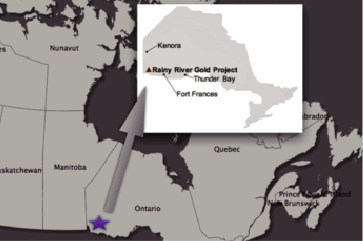
New Gold’s Rainy River project in Ontario could produce as much as 325,000 oz/y gold at an all-in cost of $736/oz, according to a recently completed feasibility study.
New Gold released the results of the feasibility study for its Rainy River gold project in western Ontario in mid-January. Highlights of the study include average annual gold production of 325,000 oz/y at total cash costs of $613/oz and all-in sustaining costs of $736/oz during the first nine years of production. Mill head grade over that time frame will average 1.44 g/mt gold. Life-of-mine production is projected at 3.4 million oz of gold and 6 million oz of silver at total cash costs of $663/oz and all-in sustaining costs of $765/oz.
New Gold acquired Rainy River Resources Ltd. and its Rainy River project in October 2013. New Gold’s development team worked with third-party consultants through the second half of 2013 to complete the current feasibility study, which builds on a study completed by Rainy River Resources in May 2013.
Development capital costs for the project are estimated at $885 million, inclusive of a $70 million contingency. Commissioning is targeted for late 2016, with first year of full production in 2017. Mine life is projected at 14 years, processing open-pit and underground ore at a rate of 21,000 metric tons per day (mt/d) for the first nine years and processing a combination of stockpile and underground ore thereafter.
The Rainy River mineral resource, effective November 2, 2013, is reported in relation to a conceptual open-pit shell at a gold cut-off of 0.30 g/mt for open-pit resources and a gold cut-off of 2.5 g/mt for underground resources. Globally, the deposit contains measured and indicated mineral resources suitable for direct processing of 106 million mt, grading 1.54 g/mt gold and 2.88 g/mt silver, and representing 5.2 million oz of gold and 9.8 million oz of silver.
In addition, the open-pit measured and indicated mineral resources suitable for stockpiling and future processing total 71 million mt at 0.43 g/mt gold and 2.09 g/mt silver, representing 1 million oz of gold and 4.8 million oz of silver.
The mineral resource estimate is based upon a geologic block model that incorporates 382,182 individual assays from more than 742,000 m of core from 1,656 drill holes.
A proposed Rainy River mining production schedule was developed through the design of a combined open-pit and underground mine within the mineral resource model. Conventional open-pit mining was chosen as the primary method to mine the deposit. Deeper, higher-grade portions of the deposit will be mined from underground.
The open-pit production schedule incorporates an elevated cut-off grade strategy during the first nine years of mining to increase the mill feed grade. Development of the underground mine would begin with the start of production from the open pit, with initial production from underground expected in 2018.
The targeted mill throughput of 21,000 mt/d will be sourced initially from the open pit and then, once in full production, the underground mine will contribute 1,500 mt/d of ore, with the balance of 19,500 mt/d coming from the open pit.
At full capacity, open-pit mining operations will be carried out by an equipment fleet comprising three 216-mm blast hole drills, one 29-m3 and two 26-m3 hydraulic shovels, one 18-m3 wheel loader, and 22 220-mt haul trucks. A 10-m bench height has been selected for mining.
Total annual mining of ore, waste and overburden will peak at 69 million mt. The operational stripping ratio, excluding waste and overburden stripping during the development phase, is 3.5:1.
The underground mine will be accessed via a 4-km decline from a surface portal located to the east of the open pit. Mining will be by longitudinal longhole open stoping. The underground mineralization occurs in sub-vertical horizons varying in width from approximately 3 m to 20 m, with the weighted average width across the various zones being approximately 8 m.
The various areas of underground mineralization provide for flexibility in the production schedule to recover higher-grade material earlier in the mine life. Longitudinal longhole open stoping in each zone will proceed in a retreating pattern from the strike extent of ore to a common access point on all levels.
Mining is scheduled to proceed upward from the lowest level of the zone, or from an adopted sill elevation, with backfill providing the working platform for each successive lift. On average, stopes 8 m in width, 20 m in length, and 20 m in height have been used for mine planning. At full capacity, ore handling from underground workings to surface will be accomplished through a fleet of four 7-m3 loaders and six 45-mt haul trucks.
The 21,000-mt/d Rainy River processing plant will use conventional crushing, grinding, leaching, carbon-in-pulp, and gold recovery technology to produce gold-silver doré. The overall design utilizes a simple and conventional flowsheet.
The Rainy River project is located 50 km northwest of Fort Frances, a town of approximately 8,000. The project benefits from proximity to existing infrastructure and is easily accessible via a network of all-weather roads that branch off the well-maintained Trans-Canada Highways 11 and 71. The Canadian National Railway is located 21 km to the south of the project.









